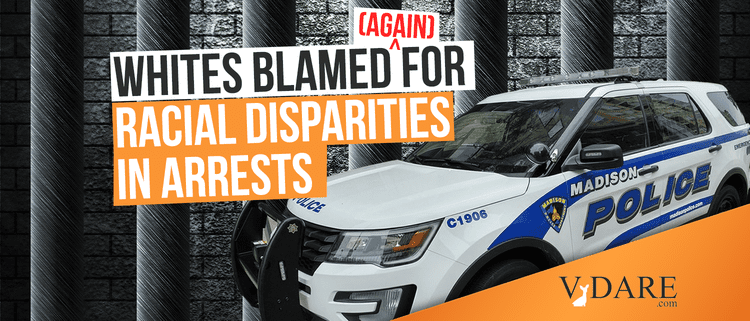There’s nothing we can do in a fight against nature. Unless, of course, we just make it illegal to arrest black people and confiscate white people’s 401(k)s for redistribution to people of color.
‘None of this has changed’: Madison’s racial disparities have gotten worse, despite decades of reports, task forces and funded programs, Madison.com, March 4, 2020
A decade ago, Dane County launched task forces to address racial disparities in the criminal justice system. A few years before that, Madison launched its Study Circles on Race program. The Madison Police Department, facing criticism for pulling over and arresting blacks at an alarming rate, began training officers to recognize their own implicit biases. And seven years ago, the Madison School District unveiled its framework to deal with the vast achievement gap between black and white students.
Today, the disparities are as wide as ever. In 2004, blacks, who made up 6% of the city’s population, accounted for about 15% of traffic citations and 29% of arrests. Last year, at 7% of the population, blacks were issued a quarter of city traffic citations, and in 2018 constituted 43% of arrests. In the same time frame, the proportion of black juveniles arrested went from 49% to 66%. In 2010, blacks made up 44% of inmates at the Dane County Jail; in 2018, it was 46%.
In Madison schools last semester, blacks who make up 18% of students, were handed 57% of all out-of-school suspensions. Last year, the district posted modest gains in black student achievement and graduation rates in its annual report, which it attributed to implementation of its 2012 framework, but the achievement gap remains among the worst in the nation.
Officials point to progress, but it’s hard to argue that Madison and Dane County are anywhere close to solving their racial disparity problems when black kids are arrested at seven times the rate of white kids, where the black unemployment rate more than doubles that of whites, and where housing costs make home ownership — and sometimes just making rent — a distant dream for poor families, who are disproportionately people of color.
All this despite years of effort by school, law enforcement, city and county officials and a variety of nonprofit groups.
“None of this has changed,” said Kaleem Caire, a local educator who’s running One City Schools, a charter school to address the challenges that keep minority and low-income kids from succeeding in school. “The achievement rate has gotten worse. The failure rate of kids has gotten worse. We would keep thinking that we were solving the problem, the United Way and all of these organizations jump on it, but it doesn’t change a thing.”
The problem, some say, is that disparities impact a population that has little political or economic clout. And white people, who control the levers of commerce and government, address only pieces of an interconnected web of issues that include child development, education, economics and criminal justice.
Brandi Grayson co-founded Young, Gifted and Black and now runs Urban Triage, an organization that provides educational support, teaches parenting skills and promotes wellness to help black families become self-sufficient.
She said elimination of racial disparities would require a seismic shift in attitude throughout society, which would take years, maybe generations. In the meantime, she said, government has to enact policies that enforce equitable treatment of people in housing, health care, education, employment and criminal justice.
 But what about Baltimore, a 70 percent black city where black people control the levers of government? If Baltimore is a food desert, where capital flees and outside corporate investments are a rarity, isn’t this but a reflection of the type of community individual blacks collectively create?
But what about Baltimore, a 70 percent black city where black people control the levers of government? If Baltimore is a food desert, where capital flees and outside corporate investments are a rarity, isn’t this but a reflection of the type of community individual blacks collectively create?
Why must we continue to see this egalitarian experiment mandated as a great moral cause, when the results decade after decade—regardless of the amount of money invested in this revolt against nature – are all the same?
It’s an old saying, first written here almost a decade ago, but it holds true: we could have been on Mars, but we decided invest untold trillions in our underclass, believing at some point in the not-to-distant future all racial disparities between blacks and whites would go away.
Well, it’s the not-to-distant future, and they’ve only gotten worse. And Mars is still 140 million miles away.













